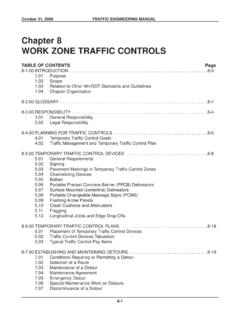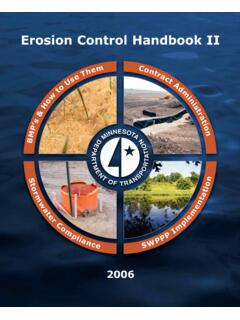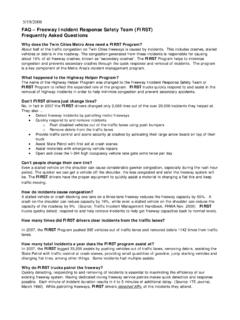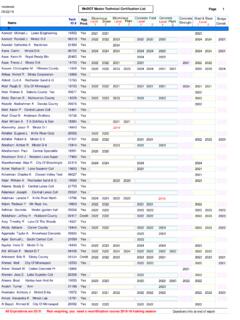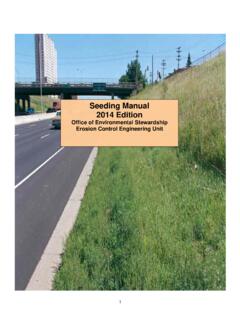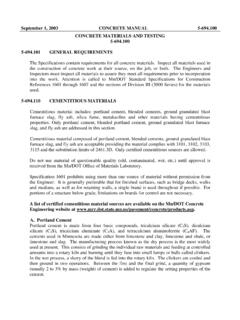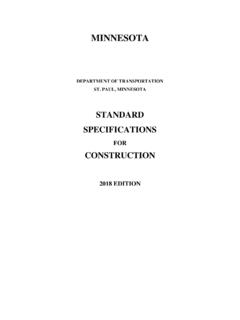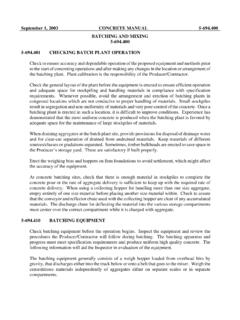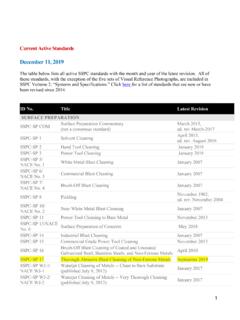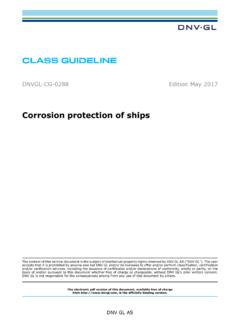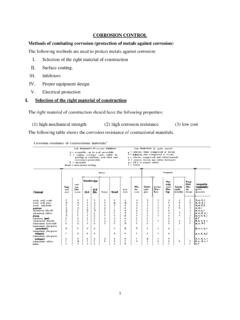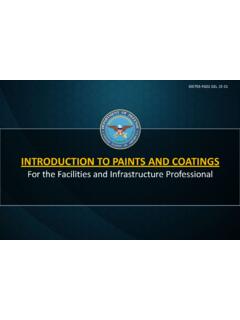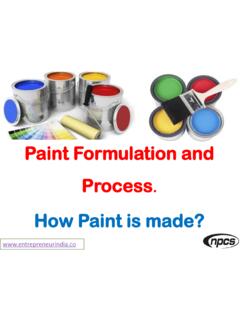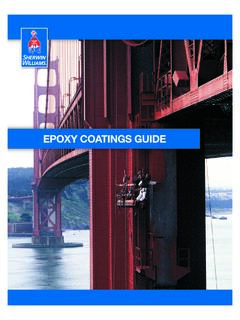Transcription of SURFACE PREPARATION AND PAINTING STRUCTURAL STEEL …
1 November 1, 2005 BRIDGE CONSTRUCTION MANUAL SURFACE PREPARATION AND PAINTING STRUCTURAL STEEL . GENERAL be utilized when available. It is advisable to obtain and follow recommendations made by manufacturers of the various PAINTING STEEL structures serves primarily to protect STEEL materials being used, or that are being removed. against corrosion (rusting) and, secondarily, to improve its appearance. Weathering STEEL (Specification 3309) forms a Although it is the Contractor's responsibility to provide for protective SURFACE which limits corrosion to a very low rate safe working conditions for workmen and Inspectors, the under mild to moderate exposure conditions. Corrosion will Inspector should be alert to conditions that may develop on the occur, however, under conditions of severe exposure, and job site which might be detrimental to the health of others as 3309 STEEL is generally painted beneath deck joints, where it is well as him or herself.
2 Many of the ingredients used in the subject to chloride spray from heavy traffic, and in industrial manufacture of paints, thinners, removers, etc. contribute to areas, where air pollution may accelerate corrosion. STEEL toxic conditions unless properly used. meeting the requirements of 3306 and 3310 do not form a protective SURFACE and must be painted for corrosion Adequate ventilation is a basic requirement. Not only can the protection. concentration of fumes from various paint associated ingredients be hazardous to health through inhalation, but they The theory of corrosion is explained in the Society for may also have a low flash point, creating a dangerously high Protective Coatings (SSPC) Manual, Volume 1 - Good explosive potential.
3 This is particularly true within PAINTING Practice under the heading "Corrosion of Metals", a enclosures, but may also occur in other confined areas which copy of which is included in (1) thru (11). The tend to trap the fumes. Spray PAINTING is especially conducive Inspector should read this explanation of the causes and to causing highly concentrated fumes and requires special effects of corrosion. The explanation will provide the protective equipment. Inspector with a better understanding of the importance attached to the protection of STRUCTURAL STEEL members. Application of heat to painted metals, which occurs when Additionally, it details the necessity for using high quality torch cutting or welding, may also create toxic fumes.
4 These materials, the insistence on proper SURFACE PREPARATION , as well fumes have been known to cause serious illness through as the proper application of coating systems. inhalation while working in confined or poorly ventilated areas. Coatings inspection includes inspection of SURFACE PREPARATION , checking the paint containers to make certain that only Silicosis is an occupational disease associated with exposure "approved" paints are used, observing the coating operation(s), to silicate dust, which may be produced during blast cleaning permitting coating to be done only under proper conditions, operations using sand abrasives. Nozzle blast operators are requiring adequate drying time between the various coats, and required to wear special helmets connected to a supply of final appearances and clean-up.
5 These are explained more clean, compressed air. Filter type air respirators and goggles fully in subsequent paragraphs and in the SSPC information should be worn by Inspectors who are exposed to blast dust. on inspection, included in (46) through (71). Regardless of the method of application of materials The Inspector should keep an accurate record of all operations. associated with PAINTING , it is important that all individuals This is particularly essential on large structures in order that a wash thoroughly before eating or leaving the job. proper sequence can be assured, without omissions, and so that inspection duties can be readily transferred to another MATERIALS. Inspector when necessary.
6 A line layout of the STRUCTURAL members, with the various operations, entered by date, The Inspector should make certain that only paint systems, provides an excellent progress record. The Inspector should which have been approved by the Department, are used. also require the Contractor to provide documentation of Several fundamentally different types of paint systems are Quality Control measurements, taken by Contractor personnel, used on construction projects. It is important to know which in accordance with 2478 or 2479 and their Quality Control type of system is in use, because materials and handling Plan (QCP). procedures differ widely among types. Inspectors should read and understand the special provisions and the paint The following safety precautions should not be considered to manufacturer's instructions for the specific system in use (the be comprehensive.)
7 They are presented here to call to the Contractor must furnish these on request), and make sure the attention of the Inspector the dangers which exist when STEEL is painters are following them carefully. Paints used must meet being cleaned, painted, cut, or welded. Additional information all the requirements of the specifications and special may be found in the SSPC Manual, Volume I, Good PAINTING provisions. Practice, Chapter 8. Other sources of information should also BRIDGE CONSTRUCTION MANUAL November 1, 2005. The most common paint systems currently used on new STEEL Foreign matter should be removed by means which will not be bridge elements are zinc-rich primers (organic or inorganic) detrimental to the STEEL , and which will not leave a residual with an epoxy mid-coat and a urethane top coat.
8 The mid-coat film on the SURFACE that cannot be wiped off. Regardless of the and top coat may also be applied over hot-dip galvanizing degree of SURFACE operations, grease and oil films should first with proper SURFACE PREPARATION . The primer, intermediate, be removed by the use of solvents or other effective methods. and top coats shall be by the same manufacturer. Each of the Solvents cover a wide range of materials, such as mineral paints used in these systems consist of two or more spirits, naphtha, coal tar solvents, alcohols, ethers, mixed components that are mixed in limited batches just before use. alcoholic-ether compounds, petroleum fractions and many Exact mixing of components is essential and the Contractor's others.
9 Many solvents give off toxic fumes and require procedures for mixing should be reviewed to verify that adequate ventilation and other precautions during their use. accurate batching is achieved. The manufacturer's recommendations should be available, and should be followed, whenever any of these materials are used. Bridge elements may be delivered to the job site unpainted, with only the prime coat, or with a full shop paint system. More detailed information on SURFACE PREPARATION , as well as Components that are fully shop painted may need to be other phases of PAINTING , can be found in The Society for touched up after erection due to shipping and handling Protective Coatings Manual, Volume I, "Good PAINTING damage.
10 The plan and special provisions may also require the Practice", which is available at the District Offices. fasteners to be painted after installation. Components that have only a shop-applied prime coat will be field painted with All visible oil, grease, soil, drawing and cutting compounds the other coats as directed in the special provisions. Most and other soluble contaminants should be removed from shop priming for later field top coating is done with an surfaces to be painted prior to hand tool cleaning, power tool inorganic zinc-rich paint. Inorganic primers should not be cleaning, or blast cleaning. Heavy deposits should be applied in the field. Handling damage shall be touched up removed with a scraper followed by scrubbing or wiping with with organic epoxy zinc-rich primer prior to applying the an appropriate cleaning solution.
